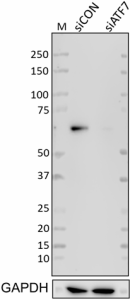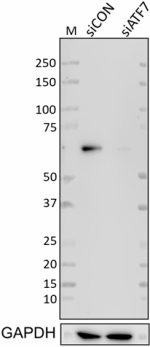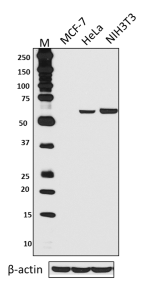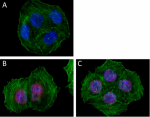- Clone
- W16152A (See other available formats)
- Regulatory Status
- RUO
- Other Names
- Cyclic AMP-dependent transcription factor ATF-7, Transcription factor ATF-A
- Isotype
- Rat IgG2a, κ
- Ave. Rating
- Submit a Review
- Product Citations
- publications

-

Whole cell extracts (15 µg protein) from HEK293 cells transfected with non-targeting control siRNA (siCON) or siRNA targeting ATF7 (siATF7) were resolved on a 4-12% Bis-Tris gel, transferred to nitrocellulose and probed with 1.0 µg/mL (1:500 dilution) of Purified anti-ATF7 Antibody, clone W16152A, overnight at 4°C. Proteins were visualized by chemiluminescence detection using HRP goat anti-rat IgG antibody (Cat. No. 405405) at a 1:3000 dilution. Direct-Blot™ HRP anti-GAPDH Antibody (Cat. No. 607904) was used as a loading control at a 1:50000 dilution (lower). Lane M: Molecular Weight marker. -

Total cell lysates (15µg protein) from MCF-7 (negative control), HeLa and NIH3T3 cells were resolved by 4-12% Bis-Tris gel electrophoresis, transferred to nitrocellulose, and probed with 2µg/mL purified anti-ATF7 (clone W16152A) antibody (upper). Proteins were visualized by chemiluminescence detection using a goat anti-rat-IgG secondary antibody conjugated to HRP. Direct-Blot™ HRP anti-β-actin Antibody was used as a loading control (lower). Lane M: Molecular Weight ladder. -

HeLa cells were fixed with 4% paraformaldehyde (PFA) for 15 minutes, permeabilized with 0.5% Triton X-100 for 3 minutes, and blocked with 5% FBS for 60 minutes. Then the cells were intracellularly stained with 0.5 µg/ml anti-ATF7 antibody (clone W16152A) overnight at 4° followed by Alexa Fluor® 594 (red) conjugated goat anti-rat IgG for one hour at room temperature. Nuclei were counterstained with DAPI (blue). The image was captured with a 40X objective.
| Cat # | Size | Price | Quantity Check Availability | Save | ||
|---|---|---|---|---|---|---|
| 697302 | 100 µg | 226€ | ||||
Activating Transcription Factor 7 (ATF7) is a member of the ATF/cAMP response element-binding protein family. Among these ATF family members, ATF7 shares highly structurally conserved N-terminal activation domain and the C-terminal DNA binding/dimerization domain with ATF2. ATF7 has no intrinsic transcriptional activity and forms functional heterodimers with c-Jun or c-Fos proteins. Upon stimulation, such as pathogen infection and various stresses, ATF7 is phosphorylated by stress‐activated protein kinase p38 at Thr51 and Thr53 and in turn resulted in the activation of ATF7 target genes. In the absence of stress, ATF silences targets genes by recruiting histone methyltransferases, leading to the formation of heterochromatin. ATF7 deficient mice die soon after birth. Double knockout mutations of ATF2 and ATF7 lead to prenatal lethality with abnormalities in liver and heart.
Product DetailsProduct Details
- Verified Reactivity
- Human, Mouse
- Antibody Type
- Monoclonal
- Host Species
- Rat
- Formulation
- Phosphate-buffered solution, pH 7.2, containing 0.09% sodium azide.
- Preparation
- The antibody was purified by affinity chromatography.
- Concentration
- 0.5 mg/ml
- Storage & Handling
- The antibody solution should be stored undiluted between 2°C and 8°C.
- Application
-
WB - Quality tested
ICC - Verified - Recommended Usage
-
Each lot of this antibody is quality control tested by Western blotting. For Western blotting, the suggested use of this reagent is 0.2 - 2.0 µg per ml. For immunocytochemistry, a concentration range of 0.5 - 2.0 µg per ml is recommended. It is recommended that the reagent be titrated for optimal performance for each application.
- RRID
-
AB_2687154 (BioLegend Cat. No. 697302)
Antigen Details
- Structure
- 494 amino acids with a predicted molecular weight of 53 kD. Contains a N-terminal transactivation domain and a C-terminal bZIP DNA binding domain.
- Distribution
-
Nucleus
- Function
- ATF7 is a transcription factor belonging to the the ATF/cAMP response element-binding protein family. ATF7 is involved in early cell signaling and is activated in response to pathogen infection and stress.
- Interaction
- Forms a homodimer or a heterodimer with c-Jun, c-Fos, and other ATF family proteins. Interacts with JNK2, TAF12, TAF4, and MAPK9.
- Biology Area
- Cell Biology
- Antigen References
-
1. Yoshida K, Ishii S. 2016. Cell Cycle. 15:3.
2. Yoshida K, et al. 2015. Nat. Immunol. 16:1034.
3. Schaeffer E, et al. 2015. Cell Cycle. 14:2655.
4. Shivers RP, et al. 2010. PLoS Genet. 6:e1000892.
5. Camuzeaux B, et al. 2008. J. Mol. Biol. 384:980.
6. Breitwieser W, et al. 2007. Genes. Dev. 21:2069. - Gene ID
- 11016 View all products for this Gene ID
- UniProt
- View information about ATF7 on UniProt.org
Related Pages & Pathways
Pages
Related FAQs
Other Formats
View All ATF7 Reagents Request Custom Conjugation| Description | Clone | Applications |
|---|---|---|
| Purified anti-ATF7 | W16152A | WB,ICC |
| Alexa Fluor® 594 anti-ATF7 | W16152A | ICC |
Compare Data Across All Formats
This data display is provided for general comparisons between formats.
Your actual data may vary due to variations in samples, target cells, instruments and their settings, staining conditions, and other factors.
If you need assistance with selecting the best format contact our expert technical support team.
-
Purified anti-ATF7

Whole cell extracts (15 µg protein) from HEK293 cells transf... 
Total cell lysates (15µg protein) from MCF-7 (negative contr... 
HeLa cells were fixed with 4% paraformaldehyde (PFA) for 15 ... -
Alexa Fluor® 594 anti-ATF7

HeLa cells were fixed with 4% paraformaldehyde (PFA) for 15...

 Login / Register
Login / Register 







Follow Us